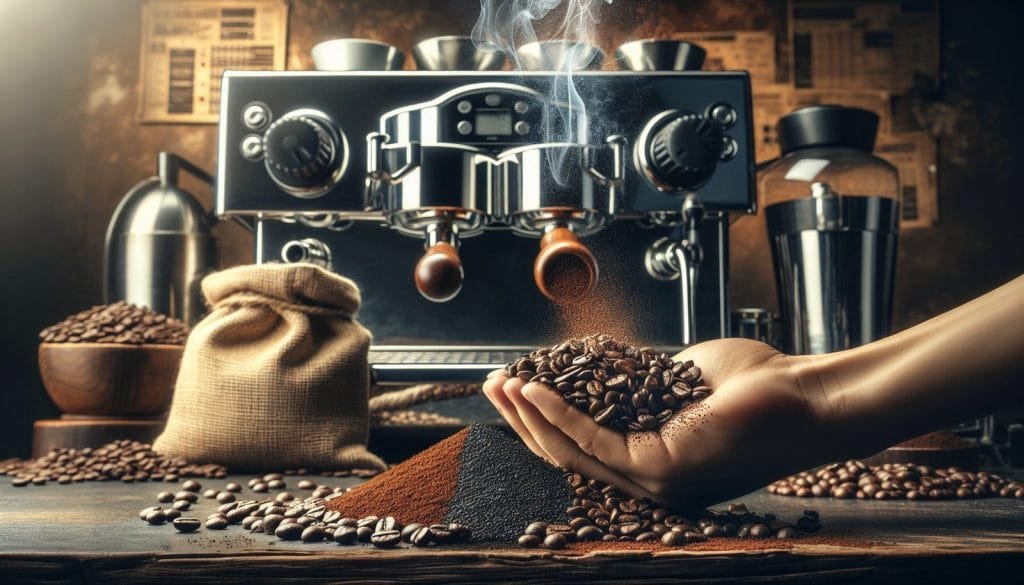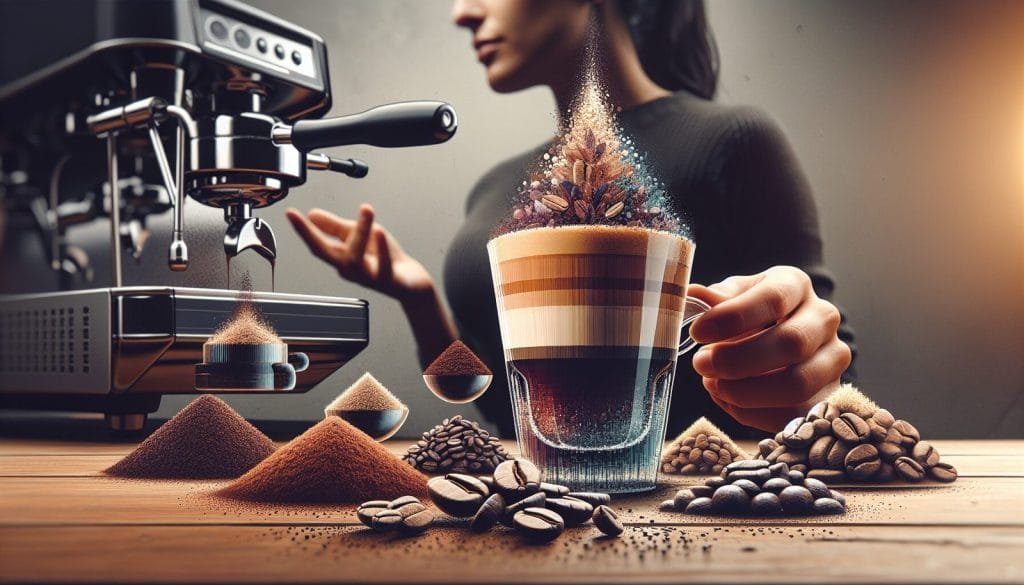When it comes to crafting the perfect cup of espresso, the grind of your coffee is paramount. The level of fineness or coarseness will greatly impact the flavor and quality of the final product. In this article, we will delve into the various grind sizes available and explore which one is best suited for an espresso machine. By understanding the importance of grind and its relationship to extraction, you will be equipped with the knowledge to elevate your espresso brewing and savor a rich and flavorsome cup every time.
The Importance of Coffee Grind in Espresso
Espresso, a concentrated form of coffee, relies on the mastery of various factors to achieve the perfect extraction. One of the most crucial components in this process is the coffee grind. The size of the coffee particles plays a significant role in determining the flavor, extraction efficiency, and overall quality of the espresso shot. Understanding the impact of grind size on espresso extraction is imperative for any coffee enthusiast or barista striving to achieve excellence in their espresso-making endeavors.
Grind Size and Extraction
The grind size directly influences the rate at which the flavors and compounds are extracted from the coffee grounds. For espresso, a fine grind is generally preferred due to the short extraction time and the need to maximize the surface area of the coffee particles for optimal extraction. A finely ground coffee allows for greater contact between the water and coffee, leading to a higher concentration of dissolved solubles and enhanced flavor extraction.
The Role of Grind Consistency
Consistency in grind size is paramount when it comes to espresso extraction. A uniform grind ensures that all coffee particles are exposed to the same brewing conditions, resulting in a consistent extraction. Inconsistent particle sizes can cause under-extraction or over-extraction, leading to a lack of balance in flavors or an unpleasantly bitter taste. Achieving a consistent grind is crucial for extracting the desired flavors and creating a harmonious espresso shot.
Impact on Flavor
The grind size significantly affects the flavor profile of espresso. A finer grind typically produces a more intense and vibrant cup, with a bolder and richer taste. The increased surface area of the finely ground coffee allows for better extraction of the desirable aromatic compounds, oils, and flavors. Conversely, a coarser grind leads to a milder and lighter flavor, as the extraction is less efficient, resulting in a less concentrated and nuanced espresso. Understanding how grind size affects flavor enables you to fine-tune your espresso brewing to achieve the desired taste profile.
Factors to Consider When Choosing the Best Grind
Selecting the appropriate grind size for your espresso machine requires considering several essential factors that can influence the extraction process and overall coffee quality.
Type of Espresso Machine
Different espresso machines have varying brewing mechanisms and extraction capabilities. Some machines rely on higher pressure to extract flavors, while others may have limitations on pressure or brewing time. Understanding the capabilities of your espresso machine is crucial in determining the optimal grind size that allows for proper extraction within the given parameters.
Bean Freshness
The freshness of the coffee beans is another critical factor to consider when choosing the grind size. Freshly roasted beans release more carbon dioxide, commonly known as degassing, shortly after roasting. This degassing process creates small bubbles that can affect the brewing process. For espresso, the general consensus is to allow the coffee beans to rest for a few days after roasting before grinding. This resting period allows the beans to degas adequately, leading to better extraction and a more balanced flavor profile.
Coffee Roast Level
The roast level of the coffee beans also plays a role in selecting the appropriate grind size for espresso. Lighter roasts are generally denser and more compact, requiring a finer grind to increase the surface area for better extraction. Darker roasts, on the other hand, are generally more porous and need a coarser grind size to avoid over-extraction and bitterness. Familiarizing yourself with the roast level of your chosen coffee can guide you in selecting the suitable grind size to highlight the desired flavors.
Brewing Time and Pressure
The brewing time and pressure settings of your espresso machine are vital considerations when determining the ideal grind size. Certain espresso brewing methods may have shorter extraction times and higher pressure, necessitating a finer grind to ensure proper extraction within the given parameters. Conversely, longer extraction times or lower pressure settings may require coarser grounds to avoid over-extraction. Experimenting with different grind sizes while closely monitoring the extraction time and pressure can help you find the perfect balance for your espresso machine.

Different Grind Sizes for Espresso Machines
When it comes to espresso, different machines require varying grind sizes to achieve the optimal extraction. Familiarizing yourself with the different grind sizes available can assist you in achieving the desired flavor profile for your espresso shots.
Extra Fine Grind
An extra fine grind size is often used in espresso machines with a high pressure extraction system, such as traditional lever-driven espresso machines or some commercial-grade espresso machines. This fine grind allows for maximum extraction within a short brewing time, resulting in a concentrated and intense flavor profile.
Fine Grind
A fine grind size is commonly used in most home espresso machines or semi-automatic machines. It allows for a relatively fast extraction while still providing a balanced and flavorful espresso shot. The fine grind ensures optimal extraction without any noticeable bitterness or over-extraction.
Medium-Fine Grind
A medium-fine grind is suitable for espresso machines that have slightly longer extraction times or lower pressure settings. This grind size provides a more delicate and nuanced flavor profile, allowing for a balanced extraction without overwhelming the palate.
Medium Grind
A medium grind size is generally not recommended for traditional espresso machines, as it may lead to under-extraction and weak flavor profiles. However, some espresso-style brewing methods, such as Moka pots or Aeropress, may benefit from a medium grind to achieve a slightly stronger extraction.
Medium-Coarse Grind
A medium-coarse grind is not commonly used for espresso machines but can be suitable for espresso-based drinks like Americanos or long blacks. This grind size allows for a faster extraction while still maintaining a rich and full-bodied taste, making it an excellent choice for those who prefer a milder espresso experience.
Finding the Perfect Grind Size for Your Espresso Machine
Determining the ideal grind size for your espresso machine may require some experimentation and fine-tuning. Several methods can assist you in finding the sweet spot for your specific machine and desired taste profile.
Trial and Error Method
One approach to finding the perfect grind size is through trial and error. Start with a baseline grind size and gradually adjust it with each brewing session, taking note of the extraction time, pressure, and flavor. This iterative process allows you to narrow down the range of grind sizes until you discover the optimal setting that consistently produces exceptional espresso shots.
Adjusting the Grinder Settings
If your espresso machine has a built-in grinder or you own a separate coffee grinder, adjusting the grinder settings can offer greater control over the grind size. Start with a finer grind and gradually increase the coarseness until you achieve the desired extraction. Keep in mind the factors mentioned earlier, such as bean freshness, roast level, and brewing time, as you make adjustments to the grinder settings.
Observing Extraction Time
Monitoring the extraction time of your espresso shots can provide insights into whether the grind size is suitable. Extraction times that are excessively short often indicate a grind size that is too coarse, resulting in under-extracted coffee. Conversely, extraction times that are excessively long may suggest a grind size that is too fine, leading to over-extracted or bitter coffee. Adjusting the grind size based on the observed extraction time can guide you towards achieving the perfect balance.

Grinding Techniques for the Best Espresso Shots
In addition to choosing the appropriate grind size, selecting the right grinding technique can enhance the quality and consistency of your espresso shots. Consider the following factors when deciding on your grinding method.
Burr Grinders vs. Blade Grinders
Burr grinders are widely regarded as the superior option for espresso grinding. They offer greater control over the grind size and produce consistent particle sizes, resulting in a more uniform extraction. Blade grinders, on the other hand, tend to produce inconsistent particle sizes, leading to an uneven extraction and potential bitterness. Investing in a quality burr grinder can significantly improve the quality of your espresso shots.
Manual vs. Electric Grinders
Both manual and electric grinders have their advantages and disadvantages. Manual grinders are often more affordable and portable, making them a popular choice for coffee enthusiasts on the go. However, they require physical effort and time to grind the beans consistently. Electric grinders, while more expensive, offer convenience and speed, allowing for quick and effortless grinding. Ultimately, the choice between manual and electric grinders depends on personal preferences and the level of convenience desired.
Pre-ground vs. Freshly Ground Coffee
Using pre-ground coffee may be convenient, but it can result in suboptimal extraction and flavor due to the loss of volatile compounds over time. Freshly ground coffee, on the other hand, allows for maximum flavor extraction and aroma. Grinding the beans right before brewing preserves the flavors and ensures a fresher and more vibrant cup of espresso. Considering the importance of grind size and extraction, investing in a grinder to grind your coffee beans freshly is highly recommended.
Common Mistakes to Avoid
To achieve the best possible espresso shots, it is crucial to avoid common mistakes that can hinder the extraction and flavor quality.
Grinding Too Fine or Too Coarse
Using a grind size that is too fine can lead to over-extraction and a bitter taste. Similarly, grinding too coarse can result in under-extraction and weak, watery shots. Finding the sweet spot between these extremes is essential for achieving a balanced and flavorful espresso.
Inconsistent Particle Size
Inconsistent particle sizes can lead to irregular extraction, with some coffee particles becoming over-extracted while others remain under-extracted. This inconsistency impacts the overall flavor, resulting in a less harmonious and subpar espresso. Ensuring a consistent grind size is crucial in avoiding this common pitfall.
Using Stale Coffee Beans
Using stale coffee beans will undoubtedly impact the flavor and quality of your espresso shots. The aromatic compounds that contribute to the complexity of the beverage degrade over time, resulting in a lackluster taste. Opting for freshly roasted beans and grinding them right before brewing allows you to extract the optimal flavors from your coffee.
Conclusion
In the realm of espresso-making, the coffee grind size is a vital factor that necessitates careful consideration. The grind size directly affects the extraction rate, flavor profile, and overall quality of your espresso shots. Understanding the importance of grind size, factors to consider when choosing the best grind, and different grind sizes for espresso machines will empower you to achieve the perfect extraction and unleash the full potential of your espresso experience. By implementing proper grinding techniques and avoiding common mistakes, you can consistently produce exceptional espresso shots that delight the senses and elevate your coffee journey to new heights.




